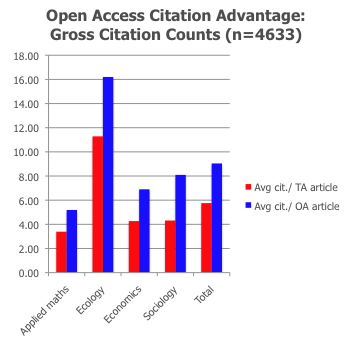Benefits to authors
A key benefit of open access for authors is that it may increase the reach of your research.
 Various studies show an OA citation advantage, e.g.
Various studies show an OA citation advantage, e.g.
"Of a sample of 4633 articles examined, 2280 (49%) were OA and had a mean citation count of 9.04, whereas the mean for TA articles was 5.76." (Norris, 2008)
Norris et al find a statistically significant difference in citation rates reflecting an average 57% OA benefit but varying across disciplines.
NORRIS, M., OPPENHEIM, C. and FYTTON, R. (2008). The citation advantage of open-access articles. J American Society for Information Science and Technology, 59(12), 1963-1972. http://www3.interscience.wiley.com/journal/117946195/grouphome/home.html or http://hdl.handle.net/2134/4083
Numerous studies find that publications in OA journals tend to be read and cited by other scholars more than similar publications in traditional journals. There is also evidence that the visibility advantage of open access publishing is particularly high in reaching non-scholarly audiences and academic audiences in less well developed parts of the world, where access to commercial journals is particularly limited. Simply having an article that is findable via Google and readable without access restriction clearly increases the likelihood that the article will be read.
Other benefits
Among many other benefits cited for OA publication are:
- "Public interest" argument that the general public should have access to publicly funded research (particularly appropriate when journal articles are produced at public research universities such as the UO, or funded by government grants)
- Equity
- within the academy why should faculty at institutions with smaller library budgets be penalized?
- Internationally high cost of journal access particularly disadvantages 3rd world
- Alignment with other "opens", e.g. open source
- Leveraging of modern web technology (implying, among other things, reduced costs by eliminating "legacy" publishing requirements like printing and subscription management)
